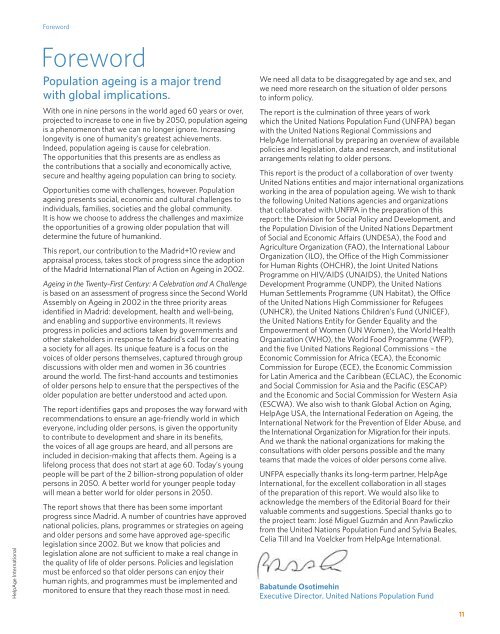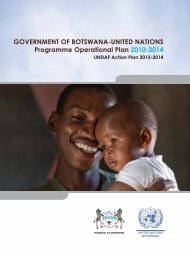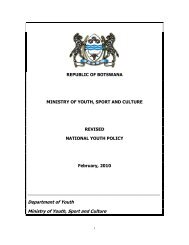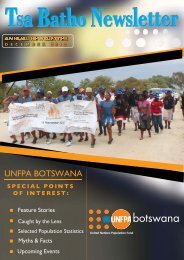Ageing in the Twenty-First Century: - HelpAge International
Ageing in the Twenty-First Century: - HelpAge International
Ageing in the Twenty-First Century: - HelpAge International
Create successful ePaper yourself
Turn your PDF publications into a flip-book with our unique Google optimized e-Paper software.
<strong>HelpAge</strong> <strong>International</strong><br />
Foreword<br />
Foreword<br />
Population age<strong>in</strong>g is a major trend<br />
with global implications.<br />
With one <strong>in</strong> n<strong>in</strong>e persons <strong>in</strong> <strong>the</strong> world aged 60 years or over,<br />
projected to <strong>in</strong>crease to one <strong>in</strong> five by 2050, population age<strong>in</strong>g<br />
is a phenomenon that we can no longer ignore. Increas<strong>in</strong>g<br />
longevity is one of humanity’s greatest achievements.<br />
Indeed, population age<strong>in</strong>g is cause for celebration.<br />
The opportunities that this presents are as endless as<br />
<strong>the</strong> contributions that a socially and economically active,<br />
secure and healthy age<strong>in</strong>g population can br<strong>in</strong>g to society.<br />
Opportunities come with challenges, however. Population<br />
age<strong>in</strong>g presents social, economic and cultural challenges to<br />
<strong>in</strong>dividuals, families, societies and <strong>the</strong> global community.<br />
It is how we choose to address <strong>the</strong> challenges and maximize<br />
<strong>the</strong> opportunities of a grow<strong>in</strong>g older population that will<br />
determ<strong>in</strong>e <strong>the</strong> future of humank<strong>in</strong>d.<br />
This report, our contribution to <strong>the</strong> Madrid+10 review and<br />
appraisal process, takes stock of progress s<strong>in</strong>ce <strong>the</strong> adoption<br />
of <strong>the</strong> Madrid <strong>International</strong> Plan of Action on <strong>Age<strong>in</strong>g</strong> <strong>in</strong> 2002.<br />
<strong>Age<strong>in</strong>g</strong> <strong>in</strong> <strong>the</strong> <strong>Twenty</strong>-<strong>First</strong> <strong>Century</strong>: A Celebration and A Challenge<br />
is based on an assessment of progress s<strong>in</strong>ce <strong>the</strong> Second World<br />
Assembly on <strong>Age<strong>in</strong>g</strong> <strong>in</strong> 2002 <strong>in</strong> <strong>the</strong> three priority areas<br />
identified <strong>in</strong> Madrid: development, health and well-be<strong>in</strong>g,<br />
and enabl<strong>in</strong>g and supportive environments. It reviews<br />
progress <strong>in</strong> policies and actions taken by governments and<br />
o<strong>the</strong>r stakeholders <strong>in</strong> response to Madrid’s call for creat<strong>in</strong>g<br />
a society for all ages. Its unique feature is a focus on <strong>the</strong><br />
voices of older persons <strong>the</strong>mselves, captured through group<br />
discussions with older men and women <strong>in</strong> 36 countries<br />
around <strong>the</strong> world. The first-hand accounts and testimonies<br />
of older persons help to ensure that <strong>the</strong> perspectives of <strong>the</strong><br />
older population are better understood and acted upon.<br />
The report identifies gaps and proposes <strong>the</strong> way forward with<br />
recommendations to ensure an age-friendly world <strong>in</strong> which<br />
everyone, <strong>in</strong>clud<strong>in</strong>g older persons, is given <strong>the</strong> opportunity<br />
to contribute to development and share <strong>in</strong> its benefits,<br />
<strong>the</strong> voices of all age groups are heard, and all persons are<br />
<strong>in</strong>cluded <strong>in</strong> decision-mak<strong>in</strong>g that affects <strong>the</strong>m. <strong>Age<strong>in</strong>g</strong> is a<br />
lifelong process that does not start at age 60. Today’s young<br />
people will be part of <strong>the</strong> 2 billion-strong population of older<br />
persons <strong>in</strong> 2050. A better world for younger people today<br />
will mean a better world for older persons <strong>in</strong> 2050.<br />
The report shows that <strong>the</strong>re has been some important<br />
progress s<strong>in</strong>ce Madrid. A number of countries have approved<br />
national policies, plans, programmes or strategies on age<strong>in</strong>g<br />
and older persons and some have approved age-specific<br />
legislation s<strong>in</strong>ce 2002. But we know that policies and<br />
legislation alone are not sufficient to make a real change <strong>in</strong><br />
<strong>the</strong> quality of life of older persons. Policies and legislation<br />
must be enforced so that older persons can enjoy <strong>the</strong>ir<br />
human rights, and programmes must be implemented and<br />
monitored to ensure that <strong>the</strong>y reach those most <strong>in</strong> need.<br />
We need all data to be disaggregated by age and sex, and<br />
we need more research on <strong>the</strong> situation of older persons<br />
to <strong>in</strong>form policy.<br />
The report is <strong>the</strong> culm<strong>in</strong>ation of three years of work<br />
which <strong>the</strong> United Nations Population Fund (UNFPA) began<br />
with <strong>the</strong> United Nations Regional Commissions and<br />
<strong>HelpAge</strong> <strong>International</strong> by prepar<strong>in</strong>g an overview of available<br />
policies and legislation, data and research, and <strong>in</strong>stitutional<br />
arrangements relat<strong>in</strong>g to older persons.<br />
This report is <strong>the</strong> product of a collaboration of over twenty<br />
United Nations entities and major <strong>in</strong>ternational organizations<br />
work<strong>in</strong>g <strong>in</strong> <strong>the</strong> area of population age<strong>in</strong>g. We wish to thank<br />
<strong>the</strong> follow<strong>in</strong>g United Nations agencies and organizations<br />
that collaborated with UNFPA <strong>in</strong> <strong>the</strong> preparation of this<br />
report: <strong>the</strong> Division for Social Policy and Development, and<br />
<strong>the</strong> Population Division of <strong>the</strong> United Nations Department<br />
of Social and Economic Affairs (UNDESA), <strong>the</strong> Food and<br />
Agriculture Organization (FAO), <strong>the</strong> <strong>International</strong> Labour<br />
Organization (ILO), <strong>the</strong> Office of <strong>the</strong> High Commissioner<br />
for Human Rights (OHCHR), <strong>the</strong> Jo<strong>in</strong>t United Nations<br />
Programme on HIV/AIDS (UNAIDS), <strong>the</strong> United Nations<br />
Development Programme (UNDP), <strong>the</strong> United Nations<br />
Human Settlements Programme (UN Habitat), <strong>the</strong> Office<br />
of <strong>the</strong> United Nations High Commissioner for Refugees<br />
(UNHCR), <strong>the</strong> United Nations Children’s Fund (UNICEF),<br />
<strong>the</strong> United Nations Entity for Gender Equality and <strong>the</strong><br />
Empowerment of Women (UN Women), <strong>the</strong> World Health<br />
Organization (WHO), <strong>the</strong> World Food Programme (WFP),<br />
and <strong>the</strong> five United Nations Regional Commissions – <strong>the</strong><br />
Economic Commission for Africa (ECA), <strong>the</strong> Economic<br />
Commission for Europe (ECE), <strong>the</strong> Economic Commission<br />
for Lat<strong>in</strong> America and <strong>the</strong> Caribbean (ECLAC), <strong>the</strong> Economic<br />
and Social Commission for Asia and <strong>the</strong> Pacific (ESCAP)<br />
and <strong>the</strong> Economic and Social Commission for Western Asia<br />
(ESCWA). We also wish to thank Global Action on Ag<strong>in</strong>g,<br />
<strong>HelpAge</strong> USA, <strong>the</strong> <strong>International</strong> Federation on <strong>Age<strong>in</strong>g</strong>, <strong>the</strong><br />
<strong>International</strong> Network for <strong>the</strong> Prevention of Elder Abuse, and<br />
<strong>the</strong> <strong>International</strong> Organization for Migration for <strong>the</strong>ir <strong>in</strong>puts.<br />
And we thank <strong>the</strong> national organizations for mak<strong>in</strong>g <strong>the</strong><br />
consultations with older persons possible and <strong>the</strong> many<br />
teams that made <strong>the</strong> voices of older persons come alive.<br />
UNFPA especially thanks its long-term partner, <strong>HelpAge</strong><br />
<strong>International</strong>, for <strong>the</strong> excellent collaboration <strong>in</strong> all stages<br />
of <strong>the</strong> preparation of this report. We would also like to<br />
acknowledge <strong>the</strong> members of <strong>the</strong> Editorial Board for <strong>the</strong>ir<br />
valuable comments and suggestions. Special thanks go to<br />
<strong>the</strong> project team: José Miguel Guzmán and Ann Pawliczko<br />
from <strong>the</strong> United Nations Population Fund and Sylvia Beales,<br />
Celia Till and Ina Voelcker from <strong>HelpAge</strong> <strong>International</strong>.<br />
Babatunde Osotimeh<strong>in</strong><br />
Executive Director, United Nations Population Fund<br />
11







